Remote Patient Monitoring enhances patient care by providing real-time health data and improving chronic disease management. This technology offers significant benefits, including timely interventions and increased patient engagement. However, challenges such as data security, patient compliance, and technology integration persist. Patient feedback plays a crucial role in assessing satisfaction and improving care quality.
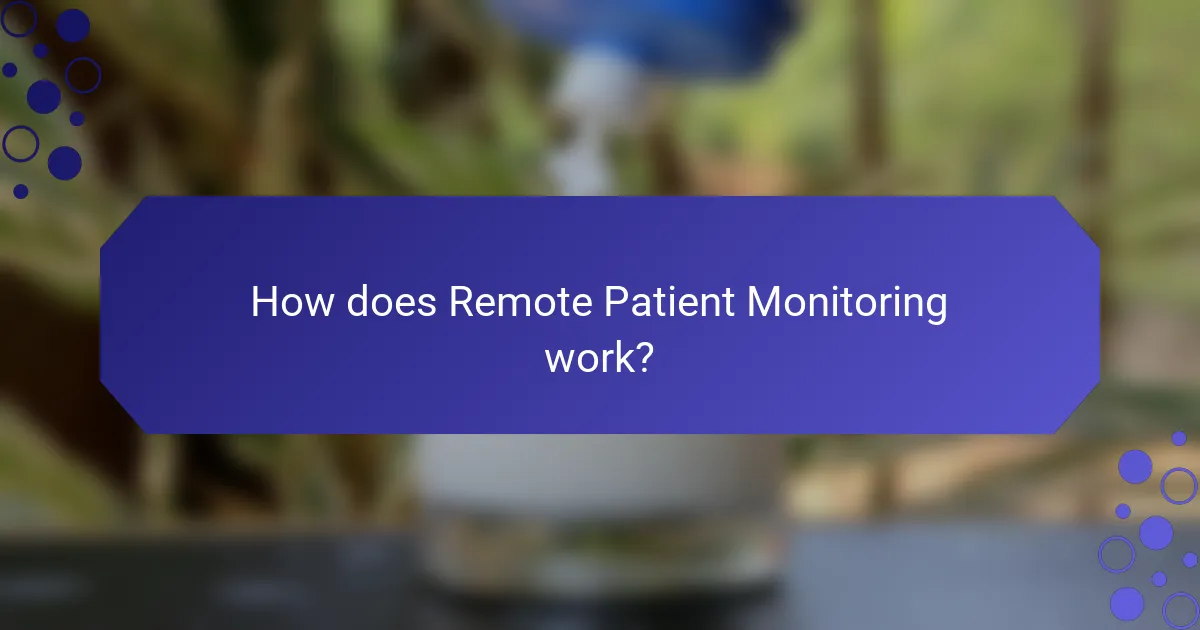
How does Remote Patient Monitoring work?
Remote Patient Monitoring utilizes digital technology to collect patient data remotely. This process involves devices that track vital signs, which are transmitted to healthcare providers in real-time. Patients benefit from continuous monitoring, leading to timely interventions and improved health outcomes. Feedback from users highlights increased convenience and engagement in their health management.
What technologies are used in Remote Patient Monitoring?
Remote Patient Monitoring utilizes various technologies including wearable devices, mobile health applications, and telehealth platforms. These tools enable real-time health data collection, enhancing patient engagement and improving healthcare outcomes. Wearable devices, such as heart rate monitors, provide continuous monitoring, while mobile apps facilitate communication between patients and healthcare providers. Telehealth platforms support virtual consultations, allowing for timely interventions. The integration of these technologies streamlines patient management and fosters proactive healthcare.
Which data is collected through Remote Patient Monitoring?
Remote Patient Monitoring collects various types of health data to track patient conditions. Key data includes vital signs, such as heart rate and blood pressure, medication adherence records, glucose levels for diabetic patients, and patient-reported symptoms. This data enables healthcare providers to make informed decisions and improve patient outcomes.
How is patient data transmitted and stored?
Patient data is transmitted and stored using secure digital platforms that ensure confidentiality. Remote patient monitoring systems utilize encrypted connections to send data from devices to healthcare providers. This data is stored in electronic health records (EHRs), which are designed to maintain patient privacy while allowing access for authorized personnel. The use of cloud storage enhances data accessibility and scalability, supporting real-time monitoring and analysis.
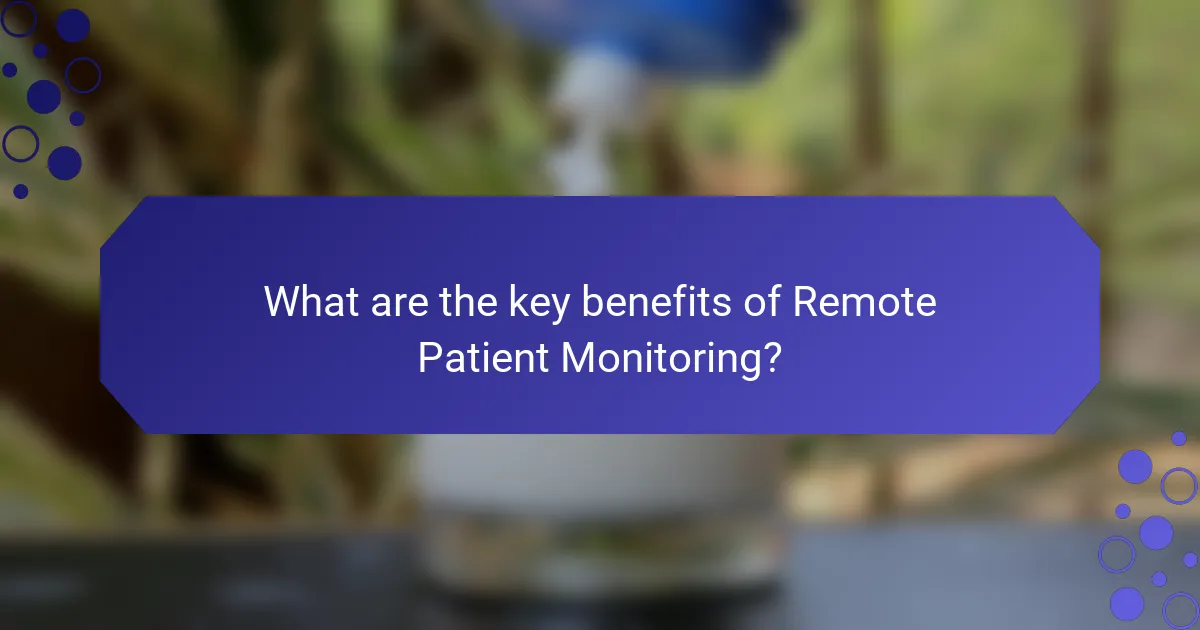
What are the key benefits of Remote Patient Monitoring?
Remote Patient Monitoring significantly enhances patient care by providing real-time health data, improving chronic disease management, and increasing patient engagement. Key benefits include timely interventions, personalized healthcare, and reduced hospital visits. These advantages contribute to better health outcomes and increased patient satisfaction. Additionally, studies show that RPM can lead to a 30% reduction in hospital readmissions, highlighting its effectiveness in managing patient health.
How does Remote Patient Monitoring improve patient outcomes?
Remote Patient Monitoring significantly enhances patient outcomes by enabling continuous health tracking and timely interventions. This technology allows healthcare providers to collect real-time data, improving disease management and reducing hospital readmissions. Studies show that patients engaged in remote monitoring experience better adherence to treatment plans, leading to a 20% improvement in overall health metrics. Additionally, personalized feedback helps patients feel more empowered and involved in their care, fostering better communication with healthcare teams.
What cost savings can be achieved with Remote Patient Monitoring?
Remote Patient Monitoring can achieve significant cost savings by reducing hospital readmissions and improving chronic disease management. By enabling continuous health monitoring, it minimizes unnecessary in-person visits and associated costs. Studies indicate that RPM can lower healthcare expenses by up to 30% through enhanced patient engagement and timely interventions. Additionally, the technology allows for efficient resource allocation, ultimately benefiting both patients and healthcare providers.
How does Remote Patient Monitoring enhance patient engagement?
Remote Patient Monitoring significantly enhances patient engagement by providing real-time health data and personalized feedback. This technology fosters a proactive approach to health management, encouraging patients to take an active role in their care.
By utilizing devices that track vital signs and symptoms, patients receive timely notifications and reminders, which can lead to improved adherence to treatment plans. Engaging patients through this continuous monitoring builds trust and strengthens the patient-provider relationship.
Moreover, studies show that patients using remote monitoring tools report higher satisfaction levels and feel more empowered in their health decisions. This increased engagement can lead to better health outcomes and reduced hospital readmissions.
In summary, Remote Patient Monitoring enhances patient engagement through real-time data, personalized feedback, and improved communication between patients and healthcare providers.
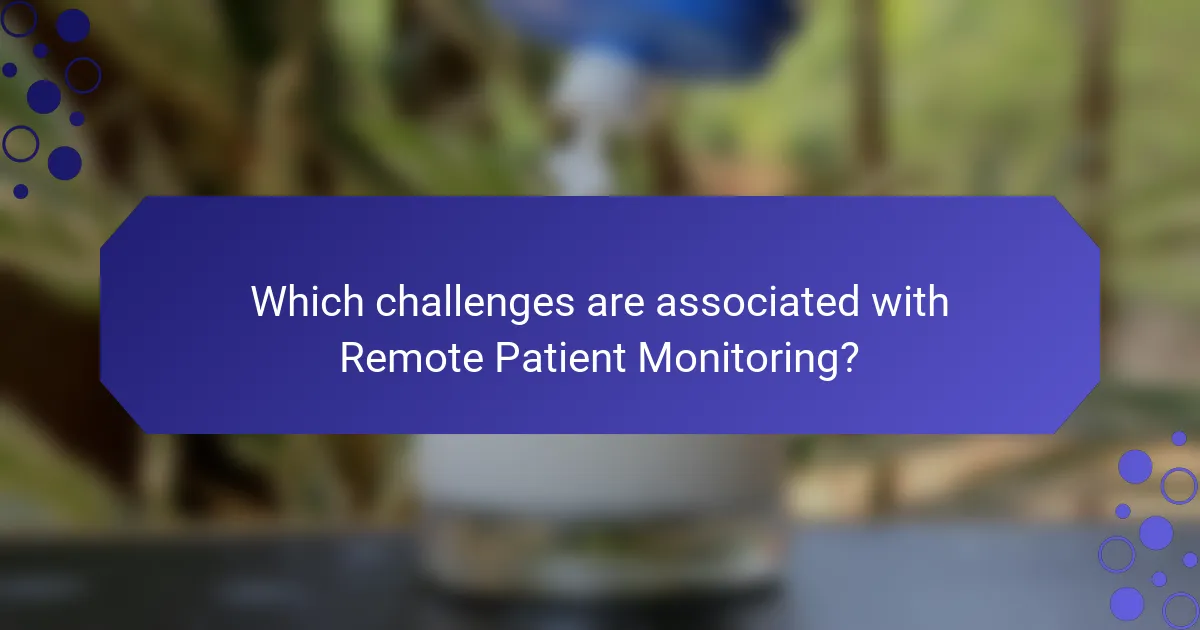
Which challenges are associated with Remote Patient Monitoring?
Remote Patient Monitoring faces several challenges, including data security concerns, patient compliance, and technology integration issues. These factors can hinder effective implementation and patient engagement.
Data security is a significant challenge, as healthcare data is sensitive and vulnerable to breaches. Ensuring robust encryption and compliance with regulations is essential.
Patient compliance varies, as some individuals may struggle with technology or lack motivation to engage consistently. This can lead to incomplete data and less effective monitoring.
Technology integration poses obstacles, as different systems may not communicate effectively, leading to fragmented data and inefficiencies. Streamlining these systems is crucial for optimal outcomes.
What are the common technical difficulties in Remote Patient Monitoring?
Common technical difficulties in Remote Patient Monitoring include connectivity issues, data security concerns, interoperability challenges, device malfunctions, user interface complications, and inadequate technical support. These obstacles can hinder effective patient monitoring and impact overall healthcare delivery.
How does patient privacy impact Remote Patient Monitoring?
Patient privacy significantly impacts Remote Patient Monitoring by ensuring data security and fostering patient trust. Secure data transmission methods, such as encryption, protect sensitive health information. Compliance with regulations like HIPAA reinforces privacy, encouraging patient participation in monitoring programs. Enhanced privacy measures lead to increased patient satisfaction and better health outcomes.
What are the limitations of Remote Patient Monitoring technology?
Remote Patient Monitoring technology has several limitations. Key challenges include data privacy concerns, potential technology malfunctions, and the need for patient engagement. Additionally, some patients may lack access to necessary devices or reliable internet connections. These factors can hinder the effectiveness of remote monitoring initiatives.
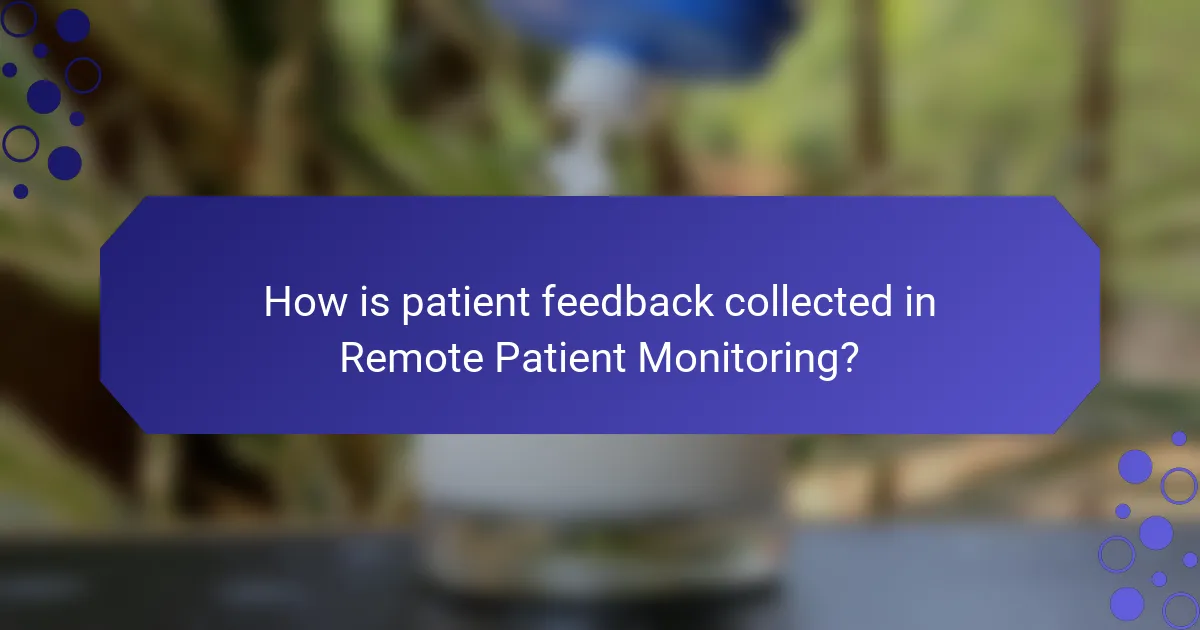
How is patient feedback collected in Remote Patient Monitoring?
Patient feedback in Remote Patient Monitoring is collected through various digital platforms, surveys, and mobile applications. These tools enable real-time communication, allowing patients to share their experiences and concerns efficiently. Feedback can be gathered via structured questionnaires, direct messaging, or integrated health apps. This data helps healthcare providers assess patient satisfaction and improve care quality. Engaging patients in this manner fosters a collaborative environment, enhancing treatment outcomes and patient adherence.
What methods are used to gather patient feedback?
Patient feedback is gathered through various methods including surveys, interviews, and digital platforms. Surveys can be sent via email or integrated into patient portals, while interviews provide in-depth insights. Digital platforms enable real-time feedback through apps or messaging. Each method enhances understanding of patient experiences and improves remote monitoring systems.
How does patient feedback influence Remote Patient Monitoring practices?
Patient feedback significantly shapes Remote Patient Monitoring practices by highlighting areas for improvement and enhancing patient engagement. Incorporating feedback leads to tailored interventions and improved health outcomes. For instance, studies show that integrating patient insights can increase adherence to monitoring protocols by 30%. This continuous feedback loop fosters a patient-centered approach, ensuring technology meets user needs effectively.
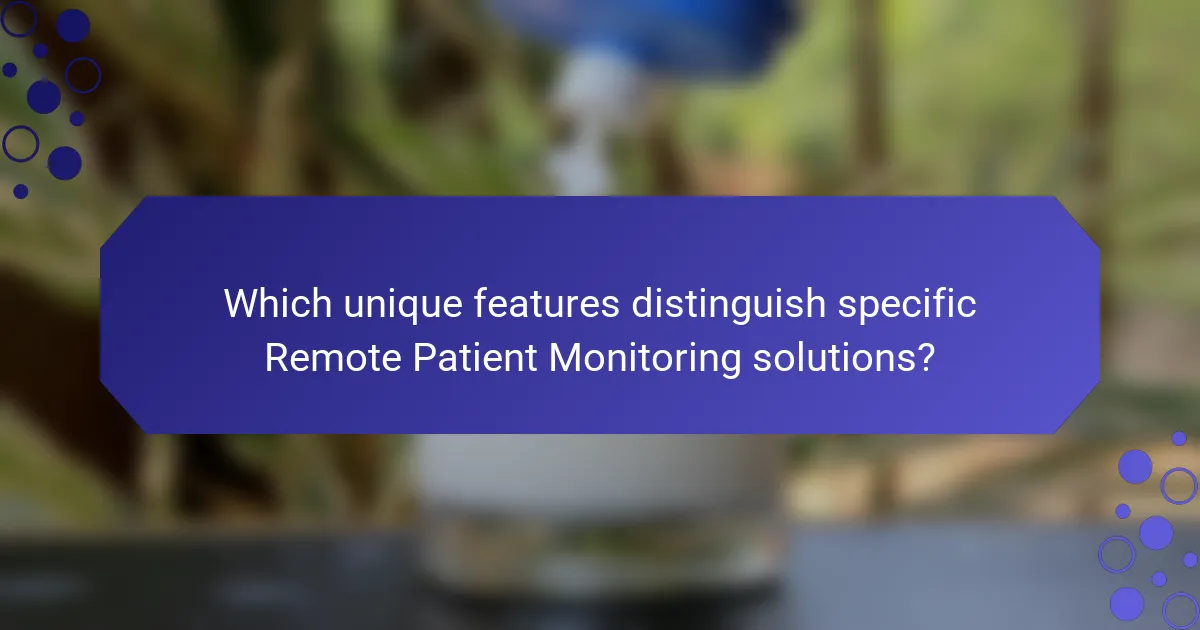
Which unique features distinguish specific Remote Patient Monitoring solutions?
Specific Remote Patient Monitoring solutions are distinguished by unique features such as real-time data analytics, customizable alerts, and integration with electronic health records. These attributes enhance patient engagement and streamline healthcare workflows.
| Feature | Description |
|—————————–|——————————————————|
| Real-time Data Analytics | Provides immediate insights into patient conditions. |
| Customizable Alerts | Allows healthcare providers to set specific notifications. |
| Integration with EHR | Ensures seamless data sharing with existing systems. |
| Remote Device Compatibility | Supports various medical devices for comprehensive monitoring. |
| Patient Engagement Tools | Includes apps for patients to track their health metrics. |
| AI-driven Insights | Utilizes artificial intelligence for predictive analytics. |
What specialized services are offered by leading Remote Patient Monitoring providers?
Leading Remote Patient Monitoring providers offer specialized services such as real-time health data tracking, personalized care plans, and remote consultations. These services enhance patient engagement and improve health outcomes. Additionally, many providers utilize advanced analytics and AI to tailor interventions based on individual patient data.
How do different platforms cater to specific patient demographics?
Different platforms tailor their remote patient monitoring solutions to specific patient demographics by addressing unique needs and preferences. For instance, platforms may focus on elderly patients by offering user-friendly interfaces and automated reminders. In contrast, solutions for younger demographics might integrate mobile app features and social sharing capabilities. Additionally, platforms catering to chronic illness patients often provide specialized monitoring tools and personalized health insights. This segmentation ensures that technology aligns with patient behaviors and improves engagement.
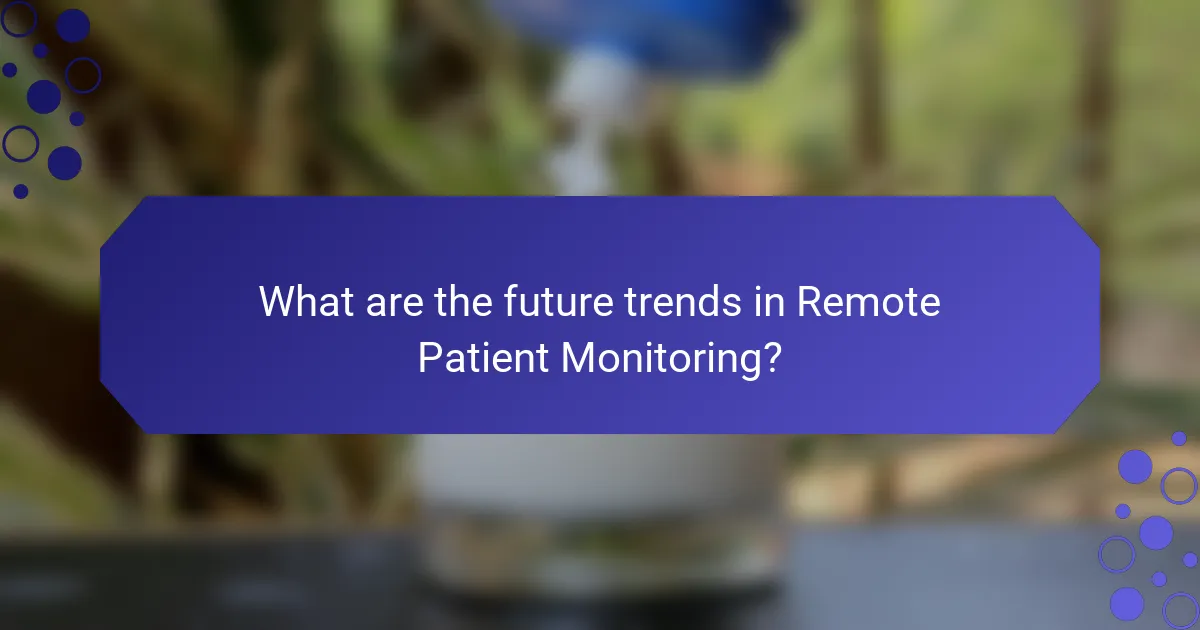
What are the future trends in Remote Patient Monitoring?
Future trends in Remote Patient Monitoring include increased use of artificial intelligence, enhanced data security, and integration with wearable technology. These advancements aim to improve patient engagement and streamline healthcare delivery. As a result, healthcare providers can offer personalized care and more efficient monitoring solutions. The growing emphasis on telehealth will further drive the adoption of remote monitoring tools, making healthcare more accessible.
How is artificial intelligence shaping Remote Patient Monitoring?
Artificial intelligence significantly enhances remote patient monitoring by enabling real-time data analysis and personalized care. AI algorithms analyze patient data, identifying trends and predicting health issues early. This proactive approach improves patient outcomes and reduces hospital admissions. Additionally, AI-driven tools facilitate seamless communication between patients and healthcare providers, ensuring timely interventions. These advancements exemplify how technology optimizes patient engagement and enhances the overall effectiveness of remote monitoring systems.
What emerging technologies are expected to enhance Remote Patient Monitoring?
Emerging technologies such as artificial intelligence, wearable devices, and telehealth platforms are enhancing Remote Patient Monitoring. AI algorithms analyze patient data for predictive insights. Wearable devices provide real-time health metrics, improving patient engagement. Telehealth platforms facilitate seamless communication between patients and healthcare providers, ensuring timely interventions. These advancements collectively improve patient outcomes and streamline healthcare processes.
How will policy changes affect Remote Patient Monitoring in the coming years?
Policy changes will enhance Remote Patient Monitoring by increasing accessibility and integration with healthcare systems. New regulations may support reimbursement for these services, encouraging wider adoption. As a result, patient engagement will improve, leading to better health outcomes. Future policies may also emphasize data privacy and security, fostering trust in technology.
What best practices should be followed to optimize Remote Patient Monitoring?
To optimize Remote Patient Monitoring, follow best practices that enhance technology integration, patient engagement, and data accuracy. Utilize user-friendly devices to ensure patient compliance. Regularly train healthcare providers on the technology to improve efficiency and response times. Implement secure data sharing protocols to protect patient information. Collect and analyze patient feedback to refine the monitoring process continually.
